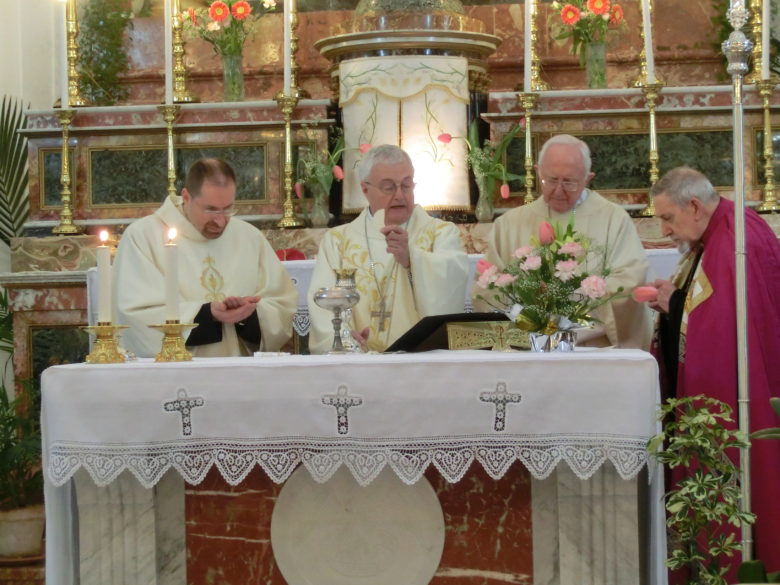From the Archives
By Mary Woodward
JACKSON – This issue of Mississippi Catholic is filled with materials about Pope Benedict’s life of service to the church. “From the Archives” would like to share some memories of the pontiff emeritus from Bishop Joseph N. Latino of happy memory.
Every so many years (it used to be strictly five) bishops from each bishops’ conference make a visit to the Vatican and meet with various dicasteries and the Holy Father. This is called an ad limina, which means “to the threshold.” In December of 2004, Bishop Latino made his first ad limina visit as a bishop to Rome and Vatican City. This visit was with the bishops of Region V of the U.S. Region V includes Kentucky, Tennessee, Alabama, Louisiana and Mississippi.
St. John Paul II was the current pope, and we have many photos from that meeting. What we do not have photos of is the visit the Region V bishops made to the Congregation (now called Dicastery) for the Doctrine of the Faith, whose prefect at that time was Joseph Cardinal Ratzinger.
Bishop Latino relayed that prior to that meeting he had always thought of Cardinal Ratzinger as a stern, somber man, but after the meeting his experience of the man changed that thinking. While some of the other prefects of other dicasteries were somewhat dismissive of the bishops’ questions, Cardinal Ratzinger was extremely gracious, patient, and respectful in answering each question posed to him.
The Cardinal took multi-layered questions and with ease and clarity answered them point by point in a way that built fraternity and dialogue, Bishop remarked. And he did all this in a soft-spoken gentile manner that endeared him to those present. A few months after that visit, St. John Paul succumbed to his human frailty in April of 2005 and the soft-spoken Cardinal became Pope Benedict XVI.
In 2006, the Vatican announced it was the 500th anniversary of the Vatican Museum because in 1506 the famous Laocoön group sculpture was excavated in Rome and placed on display in the Vatican. I always marvel at the way Rome can create a need for a pilgrimage – as if a reason was ever needed to go to Rome.

Therefore, the Diocese of Jackson put together a pilgrimage for December 2006 and Bishop Latino was the leader. We included a Wednesday Papal General Audience as part of the tour. At these audiences, bishops are ushered down to the front, on to the stage, and into chairs to the right of where the Holy Father will sit and teach the faithful gathered.
I remember Bishop Latino was the first bishop to arrive that day and after a short wrestling match with the usher, was escorted down the main aisle to his chair on the stage. For a long time, he was the only bishop on the stage and our group would call out to him to keep him from feeling alone.
Finally, another bishop arrived but unfortunately did not speak English and Bishop Latino did not speak Japanese; but soon the chairs filled, Pope Benedict arrived, and awkward pleasantries and hand gestures departed.
At the end of the audience, each bishop was able to greet the Holy Father and, in the photos, both men have such looks of joy on their faces – two kind shepherds fraternally linked. Bishop Latino always enjoyed sharing the story of this encounter with Pope Benedict.
In 2013, when Pope Benedict announced his retirement, Bishop Latino issued the following statement. I think it reflects Bishop’s respect for the kind soul that was Benedict XVI.
“On behalf of the faithful of the Diocese of Jackson I offer heartfelt prayers for Pope Benedict XVI who has made the decision to resign from the papacy on Feb. 28. Through much prayer and reflection, our Holy Father has made a decision that he feels is in the best interest of our church. The papacy is a very demanding role and position in our church. It takes great wisdom to reach a decision such as this and we admire him for acting prudently on behalf of our church and for his own sake.
“Pope Benedict has led our church since 2005. During this time, he has worked for greater understanding among faith traditions, and spoken out on behalf of truth and justice tempered with mercy. He continued to engage us in a dialogue on these truths and the dangers of moral relativism. He was committed to defending the dignity of the human person as was reflected in his writings and preaching.
“We offer him our fervent prayers for fruitful retirement years, and we thank him for his life of service to our church and indeed the world. We also offer our prayers for the College of Cardinals who guided by the Holy Spirit will soon convene to elect a successor to continue to guide and lead our church in its mission of bringing the Good News of Jesus Christ to the far corners of the world.”
R.I.P.
(Mary Woodward is Chancellor and Archivist for the Diocese of Jackson.)



















